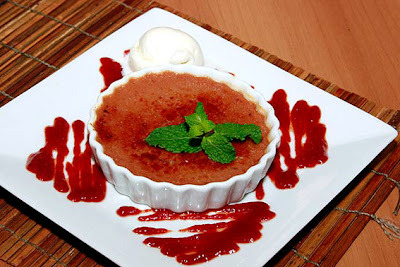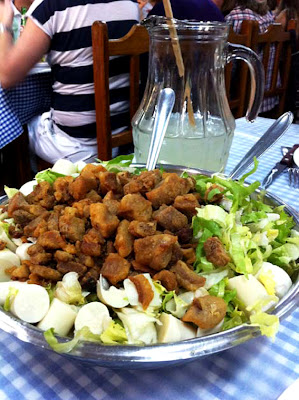 |
| Fruits of the Dendê palm |
Because of its importance to Brazilian gastronomy, and because many of this blog's readers have expressed interest in this shockingly bright orange oil, we thought that dendê deserved a post of its own. And so here it is.
Dendê oil comes from the fruit of the African Oil Palm (Elaeis guineensis), native to West Africa in the region from Angola to Gambia. Mature oil palms grow to great heights, up to 60 feet (approx. 20 meters) and produce a brilliant red fruit. It's from the pulp of this fruit that dendê oil is processed. The kernel of the fruit also is a source of oil, but that oil is called palm kernel oil in English and its use is restricted to soaps and cosmetics. The edible oil comes from the pulp.
The African Oil Palm (and naturally dendê oil) arrived in Brazil along with the millions of African slaves which were brought to this country to work the gold mines and on the sugar and cotton plantations. Even today, those areas of Brazil which have a higher black population are likely to consume more dendê, especially in those areas, like Bahia, where African cultural traditions are still vibrant. But dendê is eaten all throughout Brazil, though not always in the quantities that it's eaten in Bahia. It is still a highly-inmportant edible oil in West Africa, its original territory.
Dendê oil and its consumption by humans is a controversial topic among botanists and nutritionists. On the positive side, the bright red-orange color of the oil is due to the presence of high levels of carotenes - alpha-carotene, beta-carotene and lycophene. These phytonutrients are all highly beneficial to humans and have significant anti-oxidant properties. Studies show that dendê has up to 15 times as much beta-carotene as carrots. It is also a source of tocotrienol, part of the vitamin E family.
On the other hand, dendê oil is highly saturated, and the consumption of large quantities of saturated fats has been shown to have deleterious health effects in humans, primarily an increase in cholesterol levels. Dendê does not contain cholesterol, only animal fats do that, but highly-saturated fats can contribute to increased levels of cholesterol in humans, both LDL ("bad" cholesterol) and HDL ("good" cholesterol).
Because it is a saturated fat, palm oil is a valuable source of edible oil in the processed food industry. Saturated fats do not become rancid quickly and can be heated to high temperatures without burning. Because of this much of the world's supply of palm oil is processed for use in the food industry, and during this processing loses much of its nutritional benefit without losing any of deleterious qualities. Fortunately, as its used in traditional Brazilian cooking, unprocessed dendê oil is desired and in most cases only a small amount of that, so food scientists say that eating dendê the way Brazilians do isn't damaging to one's health.
In traditional Bahian cooking, dendê oil is used as a cooking fat in dishes such as acarajé, the iconic dish of Bahia, and as a flavoring ingredient in many of the most well-known Bahian dishes - xinxim de galinha, various moquecas, bobó de camarão, vatapá and others. As a flavoring ingredient it is most commonly combined with coconut milk, chili peppers and cilantro. It's the combination of these ingredients that for many people make a dish definably Bahian. Dendê oil is also an important ritual food in the Afro-Brazilian religion Candomblé.
 |
| Artisanally-produced dendê oil |
Because of its distinctive color and flavor, there really are no acceptable substitutes for dendê oil in recipes which call for it. The color can be approximated by the use of annatto oil, but the taste is unique. It can be purchased outside Brazil in markets which cater to Brazilian expatriot communities. It can also be found, often more easily, in market which sell African foods, or which cater to African communities. In most of these shops it will be called simply Palm Oil, or African Palm Oil. It can easily be identified by it's bright color and by the fact that some or all of the oil will be solid at room temperature.
































